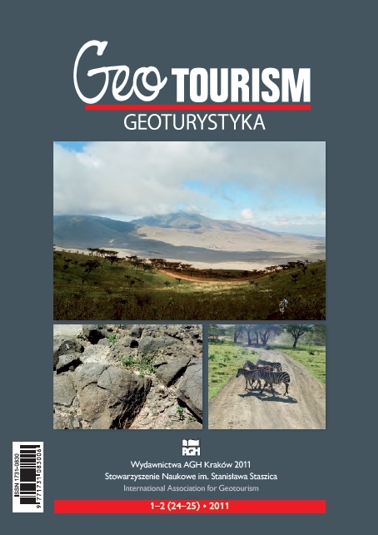The Ngorongoro Crater as the biggest geotouristic attraction of the Gregory Rift (Northern Tanzania, Africa) – geotouristic valorization, touristic development and hazard
DOI:
https://doi.org/10.7494/geotour.2011.24-25.47Słowa kluczowe:
volcanoes, Ngorongoro, Gregory Rift, East African Rift System, Tanzania, geotouristc attractions, hazardsAbstrakt
The Ngorongoro Crater, as the largest unflooded and not destroyed volcanic caldera on Earth, is one of the major geotouristic attractions of East Africa. Unique on the global scale richness of wildlife, exotic cultures of indigenous people and specific position of the Crater within the East African Rift System, each year attracts thousands of tourists eager for an unforgetable experience. Their number continues to grow from year to year, reaching the value of nearly half a million visitors within the last few years. Constantly developing tourism industry, besides many advantages, also causes a number of risks, both for the world of living nature and inanimate nature objects, as well as for the local population. In 1959, recognizing the unique and special touristic and geoeducative values of this location, the Ngorongoro Conservation Area (NCA) was established. Almost twenty years later, in 1978, the area was included in the UNESCO World Cultural and Natural Heritage List. Furthermore, within the Ngorongoro Conservation Area as well as in its immediate neighborhood there are many objects that also deserve to be called geotouristic attractions, such as: Olduvai Gorge, Crater Olmoti, Crater Empakai and Oldoinyo Lengai volcano. In a relatively short distance from the Crater also the highest mountain in Africa – the Kilimanjaro volcano and the biggest active volcano of this continent, Meru, are located.Pobrania
Bibliografia
Brilha, J., Pereira, D., Pereira, P. (eds.), 2009. Intensive Course on Geodiversity and Geological Heritage Assessment Workbook. University of Minho, 47 pp.
Dawson, J.B., 2008. The Gregory Rift Valley and Neogene-Recent Volcanoes of Northern Tanzania. Geological Society, London, 102 pp.
Diez-Martín, F., Sánchez, P., Domínguez-Rodrigo, M., Mabulla, A., Barba, R., 2009. Were Olduvai Hominins making butchering tools or battering tools? Analysis of a recently excavated lithic assemblage from BK (Bed II, Olduvai Gorge, Tanzania). Journal of Anthropological Archaeology, 28: 274–289.
Duncan, R.C., 1989. Evolution, technology, and the natural environment: A unified theory of human history. Proceedings of the Annual Meeting, American Society of Engineering Educators: Science, Technology & Society: 14B1-11-14B1-20.
Estes, R.D., Atwood, J.L., Estes, A.B., 2006. Downward trends in Ngorongoro Crater ungulate populations 1986–2005: Conservation concerns and the need for ecological research. Biological Conservation, 131: 106–120.
Fishpool, L., Evans, M. (eds.), 2001. Important Bird Areas for Africa and Associated Islands. Priority Sites for Conservation. Pisces Publications and Birdlife International, Newbury and Cambridge, U.K. BLI Conservation Series No. 11.
Leakey, L., 1965. Olduvai Gorge. A Preliminary Report on the Geology and the Fauna 1951–1961. Cambridge University Press, Cambridge.
Leakey, M.D., 1967. Preliminary survey of the cultural material from Beds I and II, Olduvai Gorge, Tanzania. In: Bishop W.W., Clark J.D. (eds.), Background to Evolution in Africa. University of Chicago Press, Chicago: 417–446.
Leakey, M.D., 1971. Olduvai Gorge. Excavations in Bed I and II, 1960–63, vol. 3. Cambridge University Press, Cambridge.
Leakey, M.D., 1976. A summary and discussion of the archaeological evidence from Bed I and Bed II, Olduvai Gorge, Tanzania. In: Isaac G.L., Mc Cowan E.R. (eds.), Human Origins, Louis Leakey and the East African Evidence. W.A. Benjamin, Inc., Menlo Park: 431–460.
Leakey, M.D., 1979. Olduvai Gorge: My Search for Early Man. Williams Collins, London.
Manega P.C., 1993. Geochronology, Geochemistry and Isotopic Study of the Plio-Pleistocene Hominid Sites and the Ngorongoro Volcanic Highlands in Northern Tanzania. Ph.D. Dissertation, University of Colorado, Boulder.
Mora, R., de la Torre, I., 2005. Percussion tools in Olduvai Beds I and II (Tanzania): implications for early human activities. Journal of Anthropological Archaeology, 24: 179–192.
Pereira, P., Pereira, D., Caetano Alves, M.I., 2007. Geomorphosite assessment in Montesinho Natural Park (Portugal). Geographica Helvetica, 13, 159–168.
Pereira, P., Brilha, J., Pereira, D., Carcavilla, L., Amrikazemi, A., Bajada, S., Barreto, J.M., Bollati, I., Braga, N., Canilho, S., Carvalhido, R., Casinhas, P., Castro, I., Cumbe, A., Dias, N., Erhartic, B., Fraga Pereira, R., Gaidzik, K., Guimarães, R., Ghiraldi, L., Kozina, K., Lima, E., Lopes, E., Loureiro, C., Mantesso, V., Martin, S., Nekouie-Sadry, B., Pereira, S., Rocha, J., Sá Lemos, H., Schilling, M., Sousa, M., Tomsa, A.M., Torres, M., Welc, E. & Zanoletti, E., 2010. Subjectivity and uncertainty in geological heritage quantitative assessment: results from fieldwork using a predefined numerical methodology. In: Mugge-Bartolovic V., Rohling H. & Wrede V. (eds.), GeoTop 2010 – Geosites for the Public, Paleontology and Conservation of Geosites. Schriftenreihe der Deutschen Gesellschaft für Geowissenschaften, 66, Hannover: 114–115.
Tombazzi, G., 2003. New map of Ngorongoro Conservation Area. Maco Editions LLC, Italy.
UNESCO/IUCN, 2007. Ngorongoro Conservation Area (United Republic of Tanzania). Report of the WHC / IUCN Reactive Monitoring Mission May 2007.
UNESCO/IUCN, 2008. Ngorongoro Conservation Area (United Republic of Tanzania). Report of the WHC / IUCN Reactive Monitoring Mission May 2008.
UNESCO World Heritage Committee, 2005. Report on the 29th Session of the Committee, Paris.
Żaba, J., 2005. The Kilimanjaro Volcano – geotouristic attraction in Africa. Geotourism, 1 (2): 3–12.
Żaba, J., Gaidzik, K., 2010. Geoturystyka – nowa interdyscyplinarna dziedzina nauk o Ziemi. Biuletyn Naukowy Wrocławskiej Wyższej Szkoły Informatyki Stosowanej. Turystyka i Rekreacja, 1: 6-13.
Żaba, J., Gaidzik, K., 2011a. The Ngorongoro Crater as the biggest geotouristic attraction of the Gregory Rift (N Tanzania, Africa) – geographical setting. Geotourism, 1–2 (24–25): 3–26.
Żaba, J., Gaidzik, K., 2011b. The Ngorongoro Crater as the biggest geotouristic attraction of the Gregory Rift (Northern Tanzania, Africa) – geological heritage. Geotourism, 1–2 (24–25): 27–46.
www.ngorongorocrater.org/welcome.html
www.iucnredlist.org



